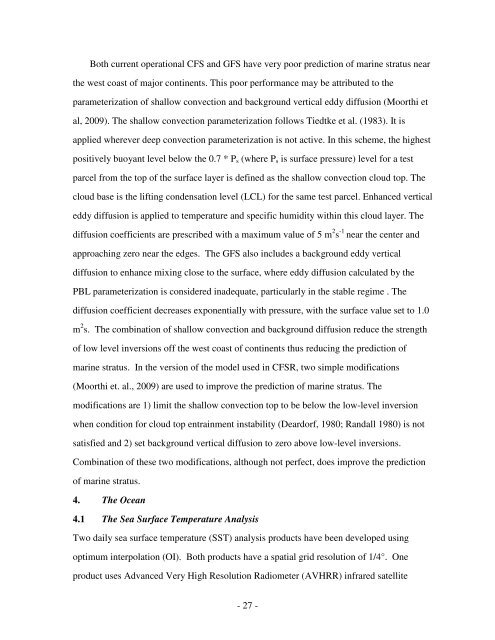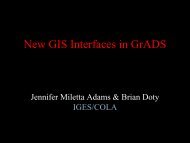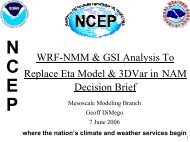The NCEP Climate Forecast System Reanalysis - NOAA National ...
The NCEP Climate Forecast System Reanalysis - NOAA National ...
The NCEP Climate Forecast System Reanalysis - NOAA National ...
You also want an ePaper? Increase the reach of your titles
YUMPU automatically turns print PDFs into web optimized ePapers that Google loves.
Both current operational CFS and GFS have very poor prediction of marine stratus nearthe west coast of major continents. This poor performance may be attributed to theparameterization of shallow convection and background vertical eddy diffusion (Moorthi etal, 2009). <strong>The</strong> shallow convection parameterization follows Tiedtke et al. (1983). It isapplied wherever deep convection parameterization is not active. In this scheme, the highestpositively buoyant level below the 0.7 * P s (where P s is surface pressure) level for a testparcel from the top of the surface layer is defined as the shallow convection cloud top. <strong>The</strong>cloud base is the lifting condensation level (LCL) for the same test parcel. Enhanced verticaleddy diffusion is applied to temperature and specific humidity within this cloud layer. <strong>The</strong>diffusion coefficients are prescribed with a maximum value of 5 m 2 s -1 near the center andapproaching zero near the edges. <strong>The</strong> GFS also includes a background eddy verticaldiffusion to enhance mixing close to the surface, where eddy diffusion calculated by thePBL parameterization is considered inadequate, particularly in the stable regime . <strong>The</strong>diffusion coefficient decreases exponentially with pressure, with the surface value set to 1.0m 2 s. <strong>The</strong> combination of shallow convection and background diffusion reduce the strengthof low level inversions off the west coast of continents thus reducing the prediction ofmarine stratus. In the version of the model used in CFSR, two simple modifications(Moorthi et. al., 2009) are used to improve the prediction of marine stratus. <strong>The</strong>modifications are 1) limit the shallow convection top to be below the low-level inversionwhen condition for cloud top entrainment instability (Deardorf, 1980; Randall 1980) is notsatisfied and 2) set background vertical diffusion to zero above low-level inversions.Combination of these two modifications, although not perfect, does improve the predictionof marine stratus.4. <strong>The</strong> Ocean4.1 <strong>The</strong> Sea Surface Temperature AnalysisTwo daily sea surface temperature (SST) analysis products have been developed usingoptimum interpolation (OI). Both products have a spatial grid resolution of 1/4°. Oneproduct uses Advanced Very High Resolution Radiometer (AVHRR) infrared satellite- 27 -





